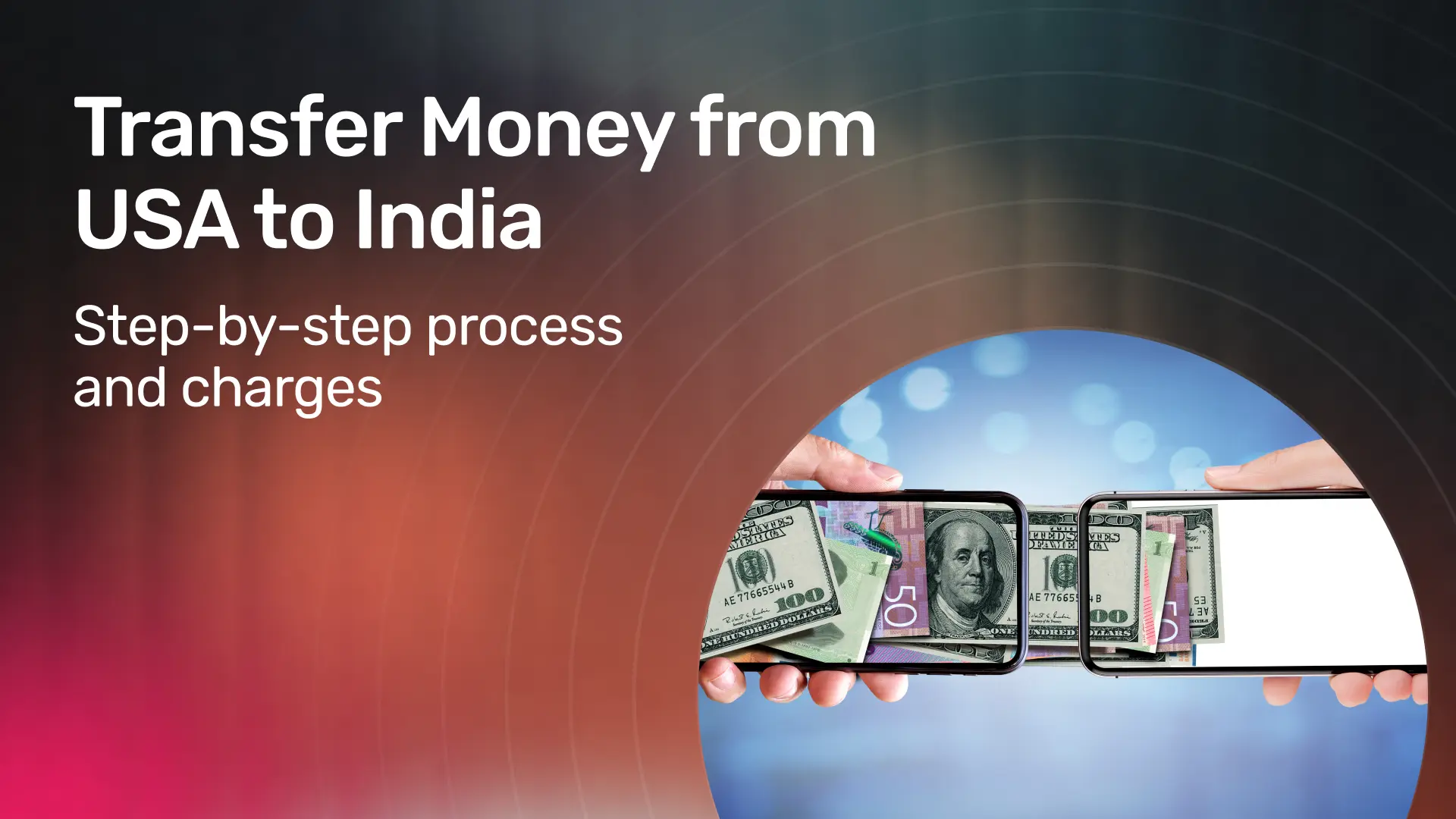Transfer Money From USA to India: Step-by-step Process and Charges
In FY24, India became the top recipient of remittances, breaking the record with $107 billion sent back by the Indian diaspora. A significant number of these transactions happen from the USA, as the USA remains a popular destination for Indian immigrants, with over 5 million Indian Americans calling it home.
For many of these individuals, sending money to India is a regular necessity, whether to support family, cover education expenses, or manage business transactions. As a result, there is always a demand for quick, cost-effective, and reliable money transfer methods.
However, with the number of options available in the market, it can be quite confusing to determine which method is best for each need. In this guide, we will break down some of the best ways to send money to India from the USA and compare their fees, speed, and key factors to help you make the right choice.

Methods for transferring money from the USA to India
There are several ways to transfer money from the USA to India, each with its own advantages and costs.
Virtual wallet transfers
Virtual wallets provide a convenient way to send money from the USA to India. These digital platforms enable users to store, exchange, and transfer funds in multiple currencies. They are becoming more popular for international transactions due to their speed and ease of use. Some widely used virtual wallets that support multi-currency transactions include Native Teams, Revolut, Payoneer, etc
General process:
- Add funds to your virtual wallet in US Dollars (USD).
- Convert USD to Indian Rupees (INR) within the platform.
- Transfer the money to the recipient’s Indian bank account or send it to their virtual wallet.
Online money transfer services
Platforms like Xe, Western Union, and Xoom allow quick and easy transfers with competitive exchange rates. These services are convenient, user-friendly, and typically have lower fees than banks.
General process:
- Choose a provider (Xe, Western Union, Xoom, etc.).
- Sign up and complete identity verification.
- Enter the recipient’s details (name, bank account number, IFSC code).
- Select the payment method (bank account, debit/credit card, or digital wallet).
- Review the exchange rate, fees, and total amount.
- Confirm the transaction and track the transfer.
- The recipient receives the money in their bank account.
Bank transfers
Many US banks offer international wire transfers directly to Indian bank accounts. However, these transfers can be costly and take a few days. Popular banks such as Wells Fargo, Bank of America, and Citibank offer remittance services for customers.
General process:
- Log in to your bank’s online portal or visit a branch.
- Navigate to the international transfers section.
- Enter the recipient’s bank details, including SWIFT/BIC code and IFSC code.
- Choose the amount and currency.
- Review fees and exchange rates before confirming.
- Authorise the transfer.
- Wait 2-5 business days for the funds to be credited to the recipient’s account.
Money transfer operators
Services like Ria Money Transfer and MoneyGram let you send money for cash pickup or direct bank deposits. These services are widely available and useful for recipients who don’t have a bank account.
General process:
- Visit a MoneyGram or Ria Money Transfer branch or use their online platform.
- Provide recipient details and transfer amount.
- Choose a payment method (cash, bank transfer, or card payment).
- Pay the required amount along with fees.
- Share the transaction code with the recipient for cash pickup or direct deposit.
- The recipient can collect the cash at a designated location or receive funds in their bank account.

Cryptocurrency transfers
Some people prefer sending money using cryptocurrencies like Bitcoin or Ethereum. This method is gaining popularity due to its lower fees and faster transaction times, but it requires both the sender and receiver to have cryptocurrency wallets.
General process:
- Buy cryptocurrency from an exchange (trusted exchanges like ByBit, Coinbase, Binance, etc.). Many users often compare Binance US and Coinbase to decide which platform offers better fees and convenience.
- Send the crypto to the recipient’s wallet address.
- The recipient converts the cryptocurrency into INR through a local exchange.
- Transfer the amount to their bank account if needed.
Cheque or demand draft
Sending a cheque or a demand draft via mail is another option, though it is slow and not commonly used. This method is mainly used for official transactions or property-related payments.
General process:
- Request a demand draft or issue a cheque from your US bank.
- Mail it to the recipient in India.
- The recipient deposits the cheque/demand draft into their Indian bank account.
- Wait for clearance (typically 2-4 weeks).
Cross-border UPI:
The international arm of the National Payments Corporation of India (NPCI), NPCI International Payments Limited (NIPL), has developed cross-border UPI capabilities. This allows NRIs to send money to India via UPI. While traditional UPI apps are primarily for domestic Indian transactions, several international money transfer services are integrating UPI capabilities. Some examples of services that provide UPI transfer options are Remitly, Wise, and Panda Remit
General process:
- Create an account or log in to your existing account on the chosen platform.
- Provide the recipient's UPI ID and the transfer amount.
- Complete the necessary sender information and any required verification steps.
- Choose your payment method (e.g., bank transfer, debit card) and complete the payment.
- Most platforms provide tracking information to monitor the transfer's progress.
Note: All the above-mentioned steps are general and may vary according to each platform.

Charges involved in transferring money to India
Transfer fees
Most services charge a fixed fee or a percentage of the transferred amount. Fees vary depending on the provider and payment method.
Exchange rate markup
Providers may add a margin to the exchange rate, reducing the amount the recipient gets. It’s essential to compare rates before making a transfer.
Other charges
Some banks may charge additional fees, especially for wire transfers. These can include intermediary bank fees and recipient bank charges.
Speed-related charges
Some services offer express transfers at a higher cost. If you need an urgent transfer, be prepared to pay extra.
Comparison at a glance
| Transfer method | Speed | Fees | Exchange rate markup | Suitable for |
| Virtual wallet transfers | Fast (minutes to hours) | Low to moderate | Competitive | Digital transactions, multi-currency users |
| Online money transfer services | Fast (minutes to hours) | Low to moderate | Competitive | Everyday remittances, personal transfers |
| Bank transfers | Slow (2-5 business days) | High | Often higher markup | Large transactions, secure transfers |
| Money transfer operators | Fast (minutes to hours) | Moderate to high | Competitive | Cash pickups, unbanked recipients |
| Cryptocurrency transfers | Fast (minutes to hours) | Low | Varies | Tech-savvy users, low-cost global transfers |
| Cheque or demand draft | Very slow (weeks) | Low | No markup | Official transactions, property-related payments |
| Cross-border UPI | Fast (minutes to hours) | Low | Competitive | NRIs, seamless UPI transactions |

Tips for saving money on transfers
- Compare exchange rates and fees: Different providers offer different rates and charges. Comparing them can help you find the best deal.
- Transfer larger amounts: Some providers charge lower fees or offer better exchange rates for higher amounts. Instead of multiple small transfers, sending one large sum may save money.
- Choose the right payment method: Using a bank transfer instead of a credit card can help avoid extra charges. Credit card transfers often have higher fees.
- Be aware of hidden fees: Look out for hidden charges like receiving bank fees or intermediary bank charges. Some services advertise low fees but add costs through exchange rate markups.
- Look for promotions: Many services offer discounts or promotional rates for first-time users. Signing up for alerts can help you take advantage of these deals.
- Use loyalty or referral programs: Some platforms provide discounts or cashback for frequent users or referrals. If you often transfer money from the USA to India, these programs can save you money over time.
Transfer money from the USA to India with Native Teams?
Native Teams is the global platform for work payments and employment that simplifies international money transfers, including sending funds from the USA to India. With its multi-currency wallet, users can easily manage cross-border payments while benefiting from competitive exchange rates and a seamless transaction experience.
How Native Teams can help:
- Multi-currency wallet – Store, exchange, and transfer USD to INR effortlessly.
- Competitive exchange rates – Get fair rates with minimal markup.
- Low transfer fees – Save money compared to traditional banking options.
- Quick transfers – Send funds to Indian bank accounts in just a few clicks.
- User-friendly platform – Manage your payments and withdrawals with ease.
- EOR and payroll integration: Perfect for businesses using Native Teams Employer of Record or global payroll services to pay international employees effortlessly.

Conclusion
To wrap it up, sending money from the USA to India has many options, and it's important to pick the right one. You can use banks, online services, or even digital wallets. Each way has different speeds, costs, and exchange rates. Knowing these differences helps you choose what's best for you. If you need money there fast, some options are quicker. If you want to save money, look for low fees and reasonable exchange rates.
A quick tip: Always compare rates, keep your details ready, and stay cautious of hidden fees or scams to ensure more of your money gets to your desired destination in India.
